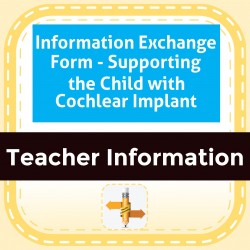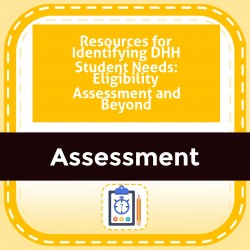Ability Levels
Categories
Resource Types
Age/Grade Range
CCSS
Anchor Standard
Speaking & Listening
Language
Reading
Customized MacArthur MCDI - Checklist Level 3 - Age 31-36 Months
$ 0
MacArthur Communicative Development Inventories (MCDI) Vocabulary Checklist Level 3. For ages 31-36 months. Receptive and Expressive vocabulary. Customized for responses that are verbal, in sign, and
...
cued.
Abbreviated Summary of Recommended Assessments
$ 0
Summary of assessment tests for students with hearing loss organized by area of evaluation needs for transition to preschool (ages 3-5) and school-age students.
ELFLing - Early Listening Function using Ling Sounds to Identify Listening Bubble Size for Young Children.
$ 0
Procedure to present Ling sounds at different distances in quiet/noise, near/far. Functional listening assessment to identify listening bubble for Ling speECH- sounds. Child response to Ling sounds -
...
pointing to images/toys, repeating sound, identifying images representing Ling sounds.
Functional Listening Function - Instructions & Scoring
$ 0
Instructions defining procedure for administering the Functional Listening Evaluation. Includes autocalculating FLE scoring and report form.
Toddler Development and Wearing Hearing Aids 18-24 Months of Age
$ 195
This
information describes toddler development for 18-24 months in terms of
successful hearing aid use and what families should be aware of, and can do
to support full-time hearing aid we
...
ar. Delves into the start of independence
skills, teaching children that only adults remove hearing aids and how to
perform a Ling sound listening check appropriate to this age range. Includes images to assist in performing the
Ling sound check.
Research Review - What do DHH Students Think About Captions
$ 0
Discussion
of a 2019 study results gathered the perspectives of DHH students regarding
their satisfaction with various aspects of captioning and areas in which
improvement is needed.
...
; Four key
findings and a summary are included
Conclusions of the OCHL Study
$ 0
Students who are hard of hearing are underrepresented in the research. The Outcomes of Children with Hearing Loss (OCHL) was a longitudinal study of more than 300 children. This article contains 10 ke
...
y conclusions learned from this study specifically for students with lesser degrees of hearing loss.
Information Exchange Form - Supporting the Child with Cochlear Implant
$ 0
This form is designed to be used, with parent permission, to gather relevant information about a child with cochlear implants or hearing aids including all service providers, hearing device informatio
...
n, communication checklist, MaP or hearing aid fitting information.
Are DHH Students Visual Learners?
$ 0
It is often assumed that students who are DHH are naturally visual learners. The evidence does not support this assumption.
Resources for Identifying DHH Student Needs: Eligibility Assessment and Beyond
$ 0
This resource is a list of functional and formal assessments to evaluate students with hearing loss in expanded core areas beyond language and academics. Links to find the sources are included. Tests
...
for preschool and school-age students are clearly identified.
 Your browser is out of date. For best experience switch to latest updated Browser.
Your browser is out of date. For best experience switch to latest updated Browser.
 Get Chrome
Get Chrome Get Edge
Get Edge Get Firefox
Get Firefox









